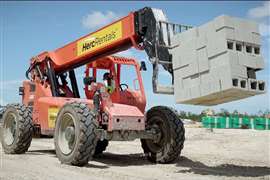Playing a waiting game - compact crushing
10 August 2012

Without question, the last few years have been challenging for almost every industry on the planet, with no sector immune from the economic woes that have afflicted us. The compact crushing and screening sector is no exception. While the major OEMs, who generally produce the majority of the larger mining and quarrying equipment, have been bolstered by the relative strength of that sector, the recycling market has been much more challenging.
But is recovery on the way? The evidence suggests not yet. Rubble Master's Harald Windner told D&Ri: "So far, there are some markets performing but others are still quiet. Germany, Sweden, Austria and Latvia are in the first group, but this year the UK is almost at zero. Last year the UK was much better. In general, the business for us is good - the market is asking for bigger machines such as our RM80 and RM100."
This was echoed by Anaconda's Con Gallagher, who said: "General conditions are still tough in a lot of markets, mainly in Europe. We are seeing some reasonable business in markets such as Germany, France and the UK, but most of Europe, especially Western Europe, is flat. New Zealand, Australia, South Africa, India and parts of the USA are showing high demand for our products."
Competition is hotting up between manufacturers of crushing and screening equipment, particularly in the compact end of the market, where flexibility and manoeuvrability are key demands.
One battleground occurs when a contractor must decide whether he requires an attachment to get the job done or whether he will invest in a compact crushing or screening unit, which traditionally would be more expensive and less versatile but feature a higher output.
But BAV Crushers claims advances in its excavator-mounted crushing attachments have driven their performance up to levels where it believes, "it is now difficult to justify the significantly higher cost of small mobile tracked crushers".
The manufacturer's BAV-CB range of crusher buckets now covers excavators from 2.5 tonnes to 25 tonnes. The buckets feature removable grids that enable two grades of output to be achieved - fine grade up to 50 mm or coarse grade between 0 and 100 mm - and powerful hydraulic jaw action, which is a twin-ram system on all but the smallest model.
Replaceable tungsten carbide teeth give aggressive penetration and are also said to be quick, cheap and simple to change.
"The BAV CB range offers an intermediate processing option, between the primary demolition tools, like the BAV Alligator Crusher attachments and stand-alone, recycling machines like the BAVTRAK tracked crushers," the company said.
Swings and roundabouts
But there are advantages on both sides. Rockster, for instance, claims that its new R700S compact crushing machine is also well-suited for jobsites where space requirements and flexibility play a major role - and it can produce up to 150 tonnes per hour.
The smallest model in the Rockster range, the R700S measures 9m long, 2.4m wide and 3.1m tall, and weighs 19.3 tonnes. These compact dimensions make the plant easier to transport and the machine also features a pivoting return/stockpile conveyor, a design which Rockster claims is unique on compact crushing plants.
The rotating mechanism allows a conveyor to be used either as a return for a closed circuit or as an additional stockpile conveyor with a discharge height of 3.4 m. In order to be easy to transport, the return/stockpile conveyer can be folded in and locked.
The R700S is built around Rockster's new R70 impact crusher, which features a hydrostatic drive to allow "a significant and material-appropriate" adjustment of revolution speed for optimal control.
The R70 also allows for infinitely variable adjustment of the upper and lower swing-beam without using any tools, while accessibility to the crusher chamber has been made easier for improved maintenance.
As an option, the R700S can also be fitted with Rockster's screening system for the production of defined final grain.
The demand from customers for very compact but high performance machines is reflected across the market.
Dieter Dorstmüller, general manager for Austrian compact crushing and screening equipment manufacturer DSB Maschinenbau, said, "Recycling and therefore the requests for crushing machines have changed over the last few years. High power and enormous output are an absolute must. In addition, sometimes the working area is really cramped - only compact and powerful machines will serve the buyer's purpose."
DSB itself has introduced a new drive system for its Innocrush range of mobile crushers. Called the Innodrive, the new system features direct power transmission, no wear parts and is maintenance free.
Economy and performance
Many of the latest crushing or screening machines have also been developed to offer very high productivity while lowering fuel consumption at the same time. And the results so far are encouraging - Metso, for instance, claims to have produced up to 30% fuel consumption savings on its new Lokotrack LT106 crusher.
Metso said this significant saving has been achieved thanks to combining a fuel-efficient Caterpillar 9.3 Tier 4-compliant engine with improved hydraulics and a larger flywheel mass.
Lokotrack LT106 product manager Jouni Hulttinen said, "Today, with rising energy prices, fuel economy is becoming more crucial for cost efficient crushing contracting. While designing the LT106, special attention was paid to the overall fuel economy. The field tests show that the targeted savings in fuel have been well reached."
Also, to improve safety for working in urban areas, the LT106 can be equipped with several optional features to minimise dust and noise emissions such as a fully encapsulated main conveyor and high pressure water spraying system.
But these fuel consumption and environmental improvements have not come at the cost of output. The machine is built around the C106 jaw crusher, which boasts increased productivity thanks new features including a material sensor for continuous choked feed. The C106 also has a large feed opening of 1 x 0.7 m (3.3 x 2.3 ft), and aggressive cavity cross section which is said to produce a high reduction ratio.
Quick relocation and setup times are also key demands from contractors, and Metso claims the LT106 also stands up well in this area. The machine has a turning side conveyor that can be transported with the unit, while its hopper walls can be tilted and opened hydraulically. The machine's transport dimensions are: length 14.2m, width 2.8m, height 3.4m and weight 40 tonnes.
Flexibility and ease of transport was a key consideration for Anaconda when it developed the FTR150 tracked feeder conveyor. It can be used as a feeder loader to control the flow of material to a crushing or screening plant and is available with an open feeder to accept all materials or can be fitted with a remote reject grid to scalp off oversize.
A vibrating grid can also be fitted if required. As with all Ananconda products, the FR150 has been designed to fit inside a standard shipping container for ease of transport.
Terex Finlay also focussed on versatility and adaptability with its new 684 tracked mobile inclined screen, which it says is suitable for use across a wide range of applications. The 684 is a compact and easily transportable unit powered by a Caterpillar C4 82kW air cooled diesel with three full size screen decks, each 4.3m by 1.7m. A combination of quick wedge tensioning, convenient access holes and hydraulic tensioning on the bottom deck is said to ensure mesh set up and change out times are kept to an minimum. Finlay says that the four discharge conveyors fold hydraulically allowing the machine to be configured for transport in less than 30 minutes.
Meanwhile, Deister's new portable heavy-duty horizontal Screening Plant with feed conveyor is also said to be a highly-mobile and versatile machine, well-suited to being transferred from site to site.
Available in 1.8 m (6 ft) by 6.1 m (20 ft) and 2.4 m (8 ft) by 6.1 m models, the units are offered in a number of custom configurations built around the Deister heavy-duty horizontal triple-shaft vibrating screen.
A 1.1 m (3.6 ft) or 1.5 m (4.9 ft) screen feed conveyer is available as an option, while other options include spring loaded belt scrapers, a receiving hopper for crusher return, a four leg hydraulic levelling package with 12 VDC power pack and filtration and optional hydraulic cylinders to fold the conveyor and adjust the discharge height
Into the future
Despite the current challenging environment, most companies are upbeat about the future and new entrants continue to appear in the sector, but is the sector set for a degree of rationalisation? That was certainly suggested by Atlas Copco's acquisition of Powercrusher in 2010. However, to date no further acquisitions have been made, and the indications are that the major crushing and screening players are focussing more on the mining, quarrying and contractor sectors, with no serious plans to move into the compact sector at this time. D&Ri posed this question to a number of the major players at the recent Hillhead show, but without exception, while stating that the sector was looked at periodically, none had even tentative plans to do so, despite a number of them having introduced new machines at the bottom end of their own size range.
Rubble Master's Harald Windner said of these moves: "Our competitors seem to be making slow and small steps down into our size range of machines, such as the RM80 and RM100 GO, but with a lot of uncertainty, which is good for us. It is not just a simple case of reducing the size of machines - there is a lot more involved such as differing customer behaviour, needs and technical requirements."
Con Gallagher of Anaconda was less sure: "As already witnessed with some of the acquisitions to date, I see some more buyouts, with some of the perceived smaller companies being taken over by larger OEMs. I also think that more new companies will appear as a result of buyouts to fill some of the niche gaps that appear as a result."
He may well be right on both counts. One OEM to watch is the biggest of them all - Caterpillar. Cat has developed a business model for what it perceives as being niche sectors, where it makes targeted acquisitions, or develops joint venture companies, to provide it with more specialised equipment. Recent examples of this include Demlone for high reach demolition machines in Europe and the establishment of a JV with waste handler specialist Genesis in the USA. When asked if this business model could be extended to include the compact mobile crushing sector, the response was that it could well be a market that might be of interest to Cat's new waste division and the model might fit well. A case of watch this space, then.
Where newcomers are concerned, evidence of this was there to see at Hillhead, with the first appearance at a mining/construction show of UK newcomer Tiger Technologies and Innovation, based in Wendover. Originally, its products were developed with the agricultural sector firmly in mind - its largest machine, the TC50 with a 50 tonne/hour through-put, takes its power from a tractor PTO - but this company is now beginning to explore the construction sector as well. It offers three different models, the TC50, the 30 tonne/hour TC30 and the 10 tonne/hour TC10.
Irrespective of the tough times the sector has gone through, and indeed is still enduring, most of the suppliers in the sector are modestly upbeat for the future. With demands growing for efficient recycling around the world, the sector offers major opportunities - it is just a question of when will the upturn come!






